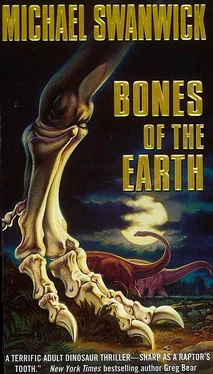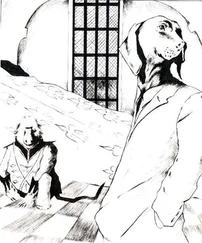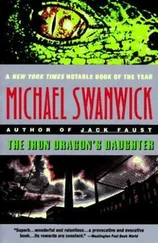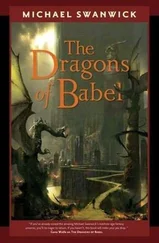The day was wet and miserable, but the rain was light and did not interfere with the ceremony. For most of the afternoon, everybody glumly carried stones from the creek to raise a small cairn over her grave, in order to keep scavengers away from her body. Just as they finished, the sun came out again.
Lai-tsz raised her head. “Listen,” she said. “Do you hear that?”
A distant murmurous sound rose up from the far side of the river. It sounded a little like geese honking.
All in a group they hurried up to the top of the hollow, where a gap in the trees afforded a partial view of the valley. There they saw that the land beyond the River Styx was in motion. Tamara scrambled up a tree and shouted down, “The herds are flooding in! They’re coming from all directions. More from the west than the east, though. I see hadrosaurs of some sort, and triceratopses too.”
“I didn’t bring my cameras!” wailed Patrick.
Tamara called down from the top of the tree, “Now they’re crossing the river! Holy cow. It’s incredible. They’re putting up so much mist you can’t see the half of them.”
Several others went swarming up the trees to see for themselves.
“Can you give us an estimate of their numbers?” Leyster shouted up.
“No way! I keep losing sight of them among the trees. Or in the water. But there must be hundreds of them. Maybe thousands.”
“Hundreds of hadrosaurs, or hundreds of triceratopses?”
“Both!”
“What are they doing on this side?”
“It’s hard to tell. Milling about, mostly. Some of the hadrosaurs appear to be breaking into smaller groups. The triceratopses are clustering.”
“So what do you think—are these guys migrating?”
“Actually, it looks like they’re moving in to stay.”
“They couldn’t have chosen a better time for it,” Katie commented. “All this young growth, freshly fertilized with titanosaur dung—it’s herbivore heaven here.”
“Damn.” Leyster thought for a moment, then said, “I want to go down by the river and get a closer look at them.” He was understating the case drastically. He had to go take a closer look. “Who here wants to go with me?”
Tamara swung down out of her tree so fast Leyster worried she would fall, singing, “Me! Me! Me!”
“Some of us should stay here,” Jamal said dubiously. “To look after the camp. Also we’ve still got the walls to put up.”
“Come with us,” Leyster said quietly. “Nobody can say you haven’t done your share of the work.”
Jamal hesitated, then shook his head. “No, really. How can I expect anybody else to work, if I’m not willing to work myself?”
* * *
The party he put together was, to Leyster’s profound disappointment, made up mostly of the food-gatherers and Daljit. Of the house-builders, only Patrick, loaded down with his cameras, broke ranks.
They moved cautiously, single file, like a jungle combat squad out of the twentieth century. Lai-tsz went first, toting one of the expedition’s four shotguns. Leyster doubted it would do much good in a confrontation with a full-sized dinosaur, but the idea was that the noise would frighten a predator away.
He sincerely hoped that was true.
They were deep into the valley flatlands before they spotted their first dinos—a clutch of hadrosaurs delicately grazing on the tender young shoots that grew thickly along the verges of the creek.
As one, all binoculars went up.
The animals paid them no attention. Every now and then one would bob up on its two hind feet and look around warily, then dip back down again. Briefly, the startling orange markings on either side of its head would erupt into the air like a burst of flame, before disappearing again into the new growth. There was always at least one keeping watch.
“What are they?” Daljit asked quietly. “I mean, I know they’re hadrosaurs, but what kind?”
Hadrosaurs, or duckbilled dinosaurs, made up a very large family grouping indeed, including dozens of known species spread throughout the Late Cretaceous. To call something a hadrosaur was like declaring a particular mammal was a feline without specifying whether it was a leopard or a house cat.
“Well, keep in mind that I’m a bone man at heart,” Leyster said. “I’d have a much easier time if there weren’t all that skin and muscle in the way.” What he really needed was a Peterson’s Field Guide to the Late Maastrichtian Megafauna, with diagnostic illustrations and little black lines pointing to all the field-marks. “Still, check out those heads. They’re definitely hadrosaurines—the non-crested duckbills. And from the elongation and width of the snouts I’d have to say they were Anatotitan. What species of anatotitan, though, I don’t know.”
“They sure are active buggers,” Daljit said. “Look at them bob up and down.”
Crouching, they crept closer. Anatotitans were herbivores, of course. But they were also enormous. An animal half as big as a bus didn’t have to be a carnivore to be dangerous.
They got within thirty yards before some unseen signal passed among the animals and, as one, they rose to their hind legs and moved swiftly away. They did not run, exactly, but their bounding gait was so quick that they were, nevertheless, gone in a moment.
“Come on,” Leyster said. “Let’s—”
Tamara was tugging at his sleeve. “Look!”
He looked back where she pointed.
The Lord of the Valley came striding upriver. Leyster recognized the tyrannosaur by its markings. It was his old acquaintance and none other.
The most dangerous predator the world had ever known glided swiftly through the low growth with a dreamlike lack of haste. His pace was unrushed, and yet his legs were so long, he moved with astonishing speed.
Silent as a shark, he strode after the fleeing anatotitans. He didn’t even give the researchers a glance as he passed by.
“Holy shit,” Patrick said flatly.
“Come on.” Leyster gestured. “We’ve got a lot of land to cover. Let’s get moving.”
They headed west, parallel to the sluggish River Styx, being careful to keep to the forest side of the herds.
As they traveled, Leyster told the others something about hadrosaurs. They knew already that hadrosaurs were the most diverse and abundant group of large vertebrates in the northern hemisphere during the closing stages of the Late Cretaceous, and that they were the last major group of ornithopods to evolve in the Mesozoic. But he wanted them to understand that in many ways hadrosaurs were a blueprint for the dinosaurs of their future. That they were so well adapted to such a variety of ecosystems that if it hadn’t been for the K-T event, their descendants might well have survived into modern times.
“So what makes them so special?” Patrick asked. “They sure don’t look like much. Why should they dominate the ecology?”
“Maybe because they’re ideal tyrannosaur chow,” Tamara said suddenly. “Look at ‘em. Almost but not quite as big as a tyrannosaur, no armor or weaponry to speak of, and that great big fleshy neck just perfect for biting. One good chomp, and down it goes! If I were a rex, I’d take good care of these critters.”
Patrick scowled. “No, seriously.”
“Seriously?” Leyster said, “They’re generalists, like we are. You’ll notice that humans don’t have many specialized adaptations either. No armor, no horns, no claws. But we can find a way to get along wherever we find ourselves. Same thing with hadrosaurs. They—”
“Shush!” Lai-tsz said. “I hear something. Up ahead.”
A lone triceratops poked its head out of the distant wood. Cautiously, it eased out into the open. It ambled a short way into the meadow, then stopped. That massive head swung to one side, and then to the other, as it searched for enemies. Finally, convinced there were none, it grunted three times.
Читать дальше






